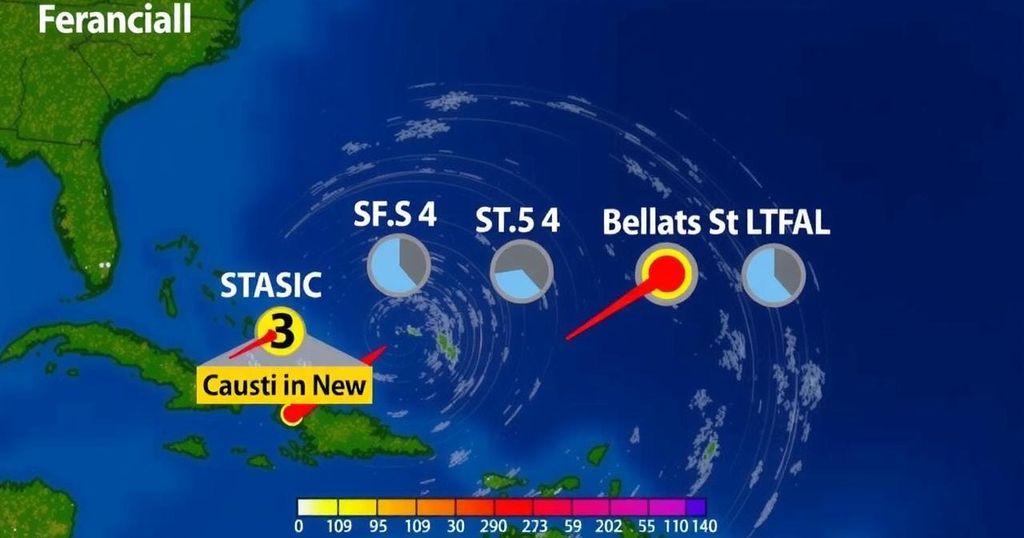2024 Atlantic Hurricane Season: An Active Year with Notable Record-Breaking Storms

The 2024 Atlantic hurricane season, concluding on November 30, was marked by 18 named storms and above-average activity, including notable hurricanes and significant impacts in the U.S. Despite an initial lull, the latter part of the season saw an uptick in storm formation, including record-setting hurricanes. NOAA’s forecasting efforts yielded improved accuracy, critical for effective disaster response planning and community preparedness.
The 2024 Atlantic hurricane season officially concluded on November 30, showcasing an unusually high degree of activity following a lull during the typically stormy peak period. This season recorded a total of 18 named storms, with 11 escalating to hurricanes and five developing into major hurricanes. Notably, five hurricanes made landfall in the continental United States, including two classified as major hurricanes. Reports from NOAA’s Climate Prediction Center confirmed that the season’s activity fell within the predicted range for both named storms and hurricanes, aligning closely with the typical averages of 14 named storms and 7 hurricanes per season.
In the aftermath of early September, a remarkable twelve named storms emerged, with a historical record of seven hurricanes and increased intensity noted after the climatological peak. Several factors contributed to the preceding lull in activity, including environmental conditions marked by significant wind and rain patterns over Western Africa that deterred storm formation. Hurricance Helene notably marked its place in history as the most lethal hurricane to strike the continental U.S. since Hurricane Katrina in 2005, claiming over 150 lives.
Additionally, Hurricane Milton gained recognition for being the strongest late-season storm recorded in the Gulf, demonstrating rapid intensification to hurricane status just a day before landfall. Beyond tracking and forecasting, NOAA’s hurricane hunters conducted extensive aerial missions, enhancing data collection and improving predictive capabilities during the season. These advancements culminated in a pilot experimental cone graphics initiative, which aims to enhance public communication regarding storm threats.
This season serves as a reminder of the ongoing need for critical scientific support and advanced forecasting tools in mitigating the impact of hurricanes. As NOAA continues to refine its forecasting and observational capabilities, a significant initiative involving data collection utilized various technologies to improve hurricane intensity predictions and response strategies.
The Atlantic hurricane season is a yearly event that runs from June 1 to November 30. The National Oceanic and Atmospheric Administration (NOAA) plays a pivotal role in forecasting hurricane activity, which involves analyzing environmental conditions, utilizing advanced meteorological technology, and modeling to predict potential storm formation. The 2024 season saw heightened activity attributed to both natural and climatic factors. NOAA provides regular updates and advisories to help protect lives and property, especially as storm impacts increasingly affect communities along the eastern seaboard of the United States. The increasing frequency and intensity of hurricanes in recent seasons has underscored the importance of scientific research and the necessity for strategic disaster response planning. Advances in hurricane forecasting and research, such as enhanced observational systems and modeling tools, have continued to evolve alongside the challenges posed by climate change. Given the amplification of hurricane effects, there exists a pressing need for ongoing improvements to ensure communities are adequately prepared to face such natural disasters.
The 2024 Atlantic hurricane season was characterized by higher-than-average activity and notable storm developments, including the record-breaking Hurricane Helene. Forecasting capabilities were significantly advanced, yielding impressive accuracy in tracking storms. The NOAA’s ongoing commitment to enhancing predictive and observational technology is critical as communities endeavor to prepare for increasing storm threats. The comprehensive data gathered throughout the season will inform future hurricane response strategies, ultimately aiming to safeguard lives and infrastructure in vulnerable coastal regions.
Original Source: www.noaa.gov






